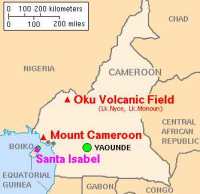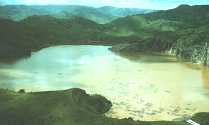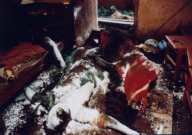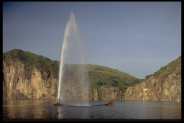LAKE NYOS (Cameroon)
The Killer lake
Overview
On the evening of 21 August1986, a tremendous explosion of CO2 from the lake Nyos, West of Cameroon, killed more than 1700 people and livestock up to 25 km away. The dissolved CO2 is seeping from springs beneath the lake and is trapped in deep water by the high hydrostatic pressure. If the CO2 saturation level is reached, bubbles appear and draw a rich gas water up. An avalanche process is triggered which results in an explosive over-turn of the whole lake. A French team has carried out since 1990 a series of tests in an attempt to release the gas slowly through vertical pipes
Geological background
Lake Nyos lies close to the axis of the Cameroon Volcanic Line, which extends for nearly 1500km from the gulf of Guinea Islands through southwestern Cameroon and into northern Nigeria and northern Cameroon. The greatest volume of material extruded and the most recent eruptions are concentrated towards the centre of the volcanic line, there have been at least nine eruptions of the Mount Cameroon since 1838 and one of the Santa Isabel volcano on the island of Bioko in 1898. Lake Nyos is a little less than 300 km to the northeast of Mt. Cameroon (Oku Volcanic field) and therefore well away from any known active volcano.

1984 ( Monoun) and 1986 ( Nyos) Disasters
The lake Nyos disaster, which claimed 1,800 victims in August 1986, was not unprecedented, but never before one had heard of mother Nature asphyxiating human beings and all terrestrial animals on such a scale in a single and brief event. Two years previously indeed, a lethal gas burst originated from the neighbouring lake Monoun, in the same remote area of Cameroon, and killed 37 people, an odd and tragic episode that went almost unnoticed. Both lakes occupy the crater of a supposedly extinct volcano, in a region known by geologists for its numerous gaseous water springs, a common feature of old volcanic areas. In both cases, without prior notice, a cloud of dense gas erupted from the lake, covering the surroundings under a deadly blanket several tens of meters thick, for an unknown amount of time. The source of the gas became clear in the aftermath of the disasters, since the normally clear waters of the lakes turned reddish and the lake shores were severely disturbed by waves and strong winds. No one in the path of the cloud managed to escape its lethal upshot. Skin discoloration found on some victims were tentatively interpreted as burns, but this diagnosis is still controversial. Witnesses on topographic highs report a loud noise originating from the lake and, in the case of lake Nyos, flashes of light visible over the lake ; both disasters occurred at night, darkness adding to the mystery of these dreadful natural catastrophes.


Nyos degassing project
Thorough investigations of the physics and chemistry of lakes Monoun and Nyos quickly revealed that both lakes still contain huge amounts of carbon dioxide (10 millions m3 and 300 millions m3 in Monoun and Nyos, respectively) and that this gas is being added at such a rate that saturation could be reached within years in the deep layers of the lakes. Since it is impossible to guarantee the perennial stability of the lakes, it has been proposed to make these lakes safer by extracting, in a controlled way, the carbon dioxide they contain. The process is no more than a limnic eruption brought under control ; it is inspired by the industrial process known as "gas lift" and, more precisely, by the methane (and CO2) extracting unit which had been operating at Gisenyi, Ruanda, on the shore of the African lake Kivu (another gas-bearing lake, but far from saturation).

|
Self-sustained
soda fountain-21 m height B.Canet ( 1995)
|
In 1992 at Monoun, and in 1995 at Nyos, M. Halbwachs and J. Grangeon demonstrated the feasibility to extract gas of these lakes. In both cases, the eruption of a gas-water mixture was primed through a 140 mm diameter pipe (made of high-density polyethylene). The measured flow-rate matched the results of a numerical modelling of the diphasic flow, as carried out by G. Kayser, and the reliability of the remotely operated control valve for stopping the flow on request was also demonstrated. Since 2001, the team led by the physicist and engineer Michel Halbwachs, then of the University of Savoie in Chambéry, France, inserted a long pipe into the middle of Lake Nyos and started to siphon up the gassy water from the lake depths.But one pipe makes for a slow extraction, leaving villagers at risk. The plan called for more pipes to be installed. After campaigning for more than a decade, the final project has been secured by donations from the United Nations Development Programme for two more pipes which were deployed in Lake Nyos between November 2010 and February 2011. Today, in March 2011, after nearly a decade, a scheme to suck a deadly build-up of carbon dioxide out of Lake Nyos is nearing its final stages.
***************************************************************************************************************************************************************************************
POSTER information presented during the Cities on Volcanoes 7 meeting in Colima - Mexico - 19th-23rd November 2012
The “Nyos Organ” program : Lake Monoun was completely degassed and Lake Nyos will be safe within five years
Michel Halbwachs (1), Henry Gaudru (2), J.C Sabroux (3), G. Kaysers (4), M. chevalier (1), J.C. Tochon-Danguy (5)
(1) Data environnement, (2) SVE, (3) IRSN, Saclay, France, (4) retired, Euratom, Cadarache, (5) Data Environnement
Correspondence: michel:halbwachs@wanadoo.fr
For more than twenty years, a French team of scientists conducted the many-sided project to enhance the safety in the surroundings of two
gas-laden crater lakes in Cameroon. The project which is made up of humanitarian, scientific and technical components was completed by the
end of 2011. The degassing technique developed in the experimental period (1990 - 2001) was applied on an industrial scale: the controlled
removal of carbon dioxide from the two lakes at a rate much higher than the rate of natural recharge, eliminating the risk of another gas burst
from these lakes.
Three columns installed between 2003 and 2006 allowed to totally degas Lake Monoun in late 2009. At Lake Nyos, the first column was
installed in 2001 and worked non stop since then. Two columns of larger diameter were added in 2011. Since then, the fountains of water and
gas 50 meters height have been reduced to 10 meters. Due to the safety requirements and the uniqueness of the experiment at such a scale, its
influence on the physical, chemical and biological features of the lake deserves a close scientific scrutiny.
This poster document described some scientific and technical issues of the overall project and presents data bearing to the response of some
limnological key parameters to the ongoing degassing process.
A schedule of the future Nyos internal structure was calculated using the efficiency of the extraction of water as inferred from the evolution of the gas concentration depth distribution.